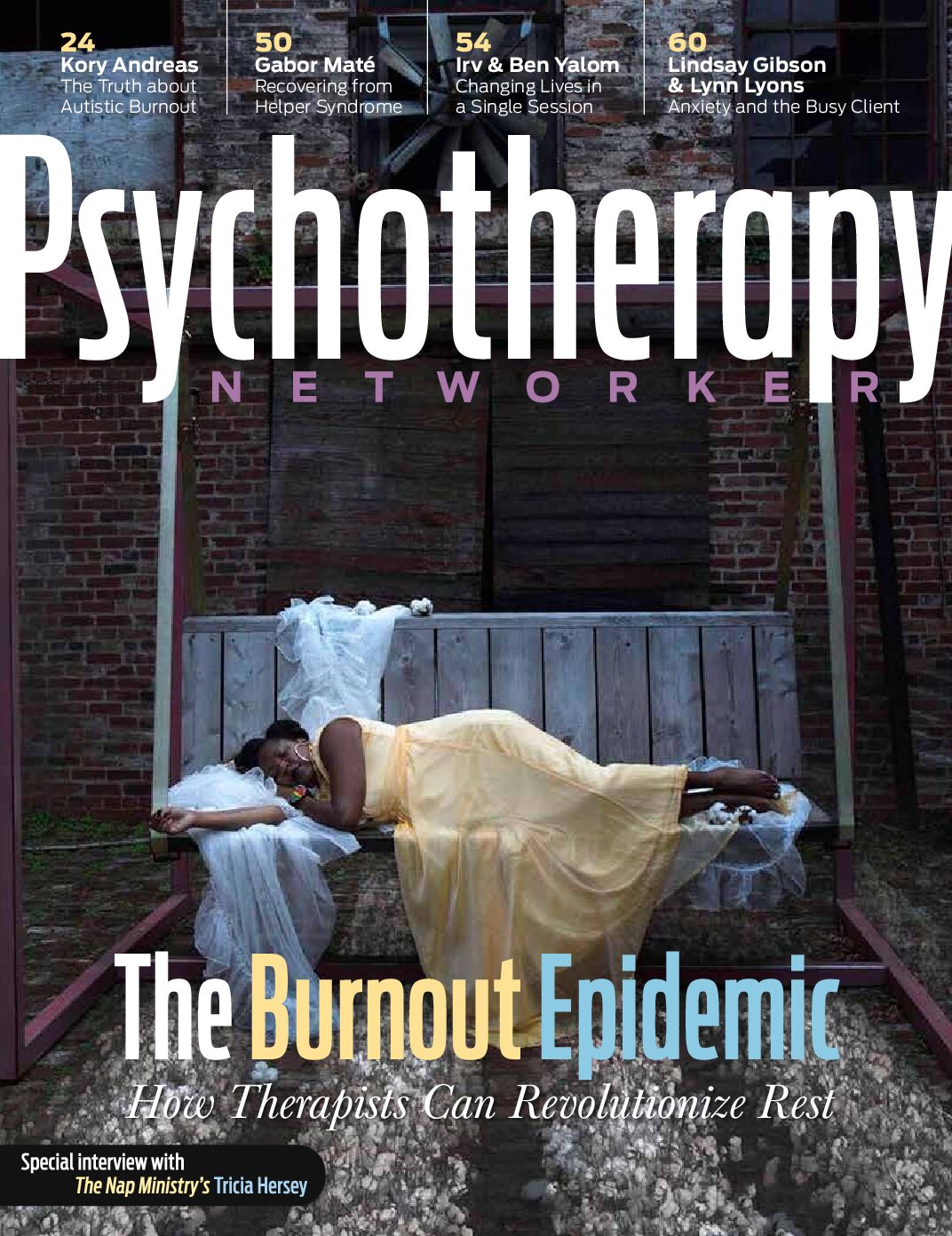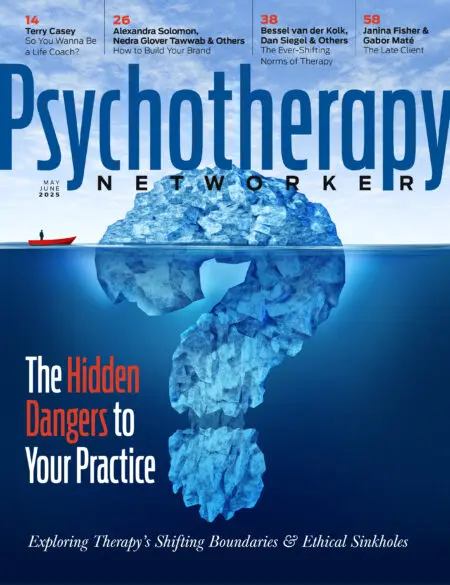We’ve all had moments, sometimes entire cases, when the therapy seems stuck, our wheels spinning in the mud, unable to get any traction. Nothing we say breaks through the client’s dogged negativity, convinces her to take even a small step forward, or gets her to look more directly at her own self-destructive behavior. At these times, the tightness in our bodies can lead to thoughts like “Is this why I went through years of graduate school? Maybe I should get a job as a Walmart greeter!”
When clients get immersed in their problem, they often suffer from a kind of tunnel vision, focused on a small range of experiences, with their bad feelings taking center stage. It’s a state that resembles a hypnotic trance: a limited, intense, internal focus of attention. When therapy gets stuck, one way of moving it forward can be to think of clients as being in a troublesome trance induced by parents, caregivers, and difficult life experiences. They’re trapped in what Buddhists call maya, the world of illusion.
When therapy goes wrong, it’s typically because we’ve entered our clients’ trances with them, joining them in their myopic misery. In this mutually reinforcing state, neither client nor therapist can see beyond the small, cramped space of the stalled interaction. Focused entirely on the bad feelings generated by the problem at hand, we lose our capacity to use our skills to expand life’s horizons, oblivious to other possibilities for change—other ways of thinking and responding.
Once caught in such a trance, we need to break the spell, broaden our vision, and open ourselves to possibilities outside it. These goals may present a formidable challenge, but meeting it can be easier than you think, particularly with practice. To determine whether you are, in fact, in a trance when treatment has stalled, ask yourself the following questions, and consider the added suggestions for mobilizing your—and, more importantly, your client’s—capacity for more creative thinking.
The Feelings Trap
Are you focusing too much on the client’s feelings and too little on the triggers that elicit them?
Your client comes in, depressed as usual and totally miserable. She’s in a time warp: as far as she’s concerned, she’s always been depressed, will always be depressed, and, much of the time, feels herself to be depression incarnate. Or your client is angry much of the time, walks into every session with a chip on his shoulder and a show-me attitude. Session after session of this can wear you down: feelings are contagious, and it’s easy to catch the bug your client is carrying. When a client is in thrall to anxiety, sadness, fear, anger, or self-loathing, it can be hard for either of you to focus on anything else.
Many of us have been taught to focus on exploring clients’ feelings. That’s what therapists do, isn’t it? Of course, it’s important to know what the pertinent feelings are, validate them, and, if clients are puzzled about them, dissect their distinctive meanings. However, rather than continuing to circle around the bottomless drain of feelings, it’s usually useful to find out what’s causing the feelings and intervene there.
So the first principle of moving stuck therapy along is to recognize that feelings aren’t an ultimate reality, but just important signals, much like the warning lights on a car’s dashboard. What’s important isn’t the light itself, but what causes the light to go on. If the oil light in your car refuses to go off, there’s no point in studying the light; you need to put oil in the engine and see whether the light goes off. Clients’ feelings are useful signals offering you instant feedback about the effectiveness of therapy, but your interventions themselves need to be directed elsewhere.
One woman I saw had been in therapy for more than a year exploring her unhappiness with nearly every aspect of her life. When she walked into my office for the first time, her tense and pained face, her shallow breathing, and her slumped shoulders announced her misery before she’d said a word. After sincerely acknowledging her quite obvious distress, I took a more objective “scientific” attitude of curiosity. How did it happen that she was dissatisfied about everything? I asked. Was she a perfectionist with such high standards that the real world couldn’t meet them? Or had she just been having incredibly bad luck?
A little exploration revealed that she had a terrible way of making decisions. Even a decision about what to order for lunch in a restaurant became an ordeal in which an anxious internal voice said, “What are other people having?” countered immediately by another voice, saying in an annoyed, critical tone, “No, think for yourself!” followed by unpleasant feelings of frustration and self-dislike. These voices continued to argue until, when she felt bad enough, a third voice would say, “Choose anything; it’ll be better than this!”—leading her to choose at random to end the agony of indecision. Since random choices almost never fit her real preferences or values, she was usually unhappy with them.
I first taught her a more effective way of making decisions that were in alignment with her preferences. I rehearsed her in imagining picking out a meal, a dress, and a movie that would satisfy her tastes and give her pleasure, emphasizing an internal voice asking, “What would I like?” She was still unhappy with many of the decisions she’d made previously, but now she had an effective way to review them and extricate herself from them and the bad feelings associated with them.
The Judgment Trap
Are you or your clients distracted and distressed by judgments about their problems?
As if having bad feelings weren’t bad enough, many clients criticize their bad feelings, making them feel even worse. “You shouldn’t feel bad!” “You’re being a silly goose about this.” “Can’t you be a man and ‘suck it up’?” Any judgment adds yet another layer of trance, distancing clients even further from their problems and any possible solutions.
Whenever a client describes his or her feelings as “bad,” it can be useful to point out that these feelings are effectively good. Like pain or the trouble light on your dashboard, they signal that something needs attention. Clients who don’t have these feelings might fail to heed the underlying issue and suffer further consequences. People born without pain receptors continually damage their bodies because they lack vital feedback. Even just changing a description from “bad” to “unpleasant” can redirect attention from trying to eliminate the feeling—as addicts and many others do—to solving the problem that causes it.
Years ago, I was invited by Bill, a career Air Force psychiatrist, to teach the staff at his base a little about Gestalt therapy. Afterward, as we walked to my car, Bill opened up to me about his unhappiness with life in the military. Despite the good salary, the free healthcare, and the other benefits that kept him there, he found himself bridling at rules and restrictions he disliked intensely and avoiding conflicts that might get him in trouble with his superiors. At one point, he said wearily, “I pay a terrible price for all those benefits.” Just wanting to be friendly, I said, “Well, I guess we all have our price,” meaning that we all sometimes have to make compromises in a less-than-perfect world, and that benefits never come to us without some kind of cost.
Later, I learned that my simple “we” comment, which took no more than six seconds to say—an example of ultrabrief therapy—expanded the scope of Bill’s thinking, helping him realize how common his situation was. By allowing him to discard his self-judgment, this normalization helped him examine the price he was paying and, eventually, move on to an emotionally less costly life.
When clients think of their problems (and sometimes themselves) as being weird or abnormal, they’re comparing themselves with a standard or ideal. Giving them a new comparison—particularly by using extreme and absurd examples—can open up their inner world and help them expand the scope of their thinking. For instance, if a client says he has a lot of fears, you can ask, in a curious and interested voice, “Oh, are you one of those people who’s afraid of dust mites under the bed? Do you worry that someone is going to go through your trash and save your fingernail clippings to make a voodoo doll and put a hex on you? Do you worry about a passing airplane dropping a piece of ‘blue ice’ from the toilet on your head? Just how bad is this?”
Usually the client will laugh, and say, “No, no, it’s not that bad!” and go on to correct you and clarify what he is afraid of, but from a different perspective and feeling state. In contrast with extreme examples, clients may come to see their problems as much less weird—and therefore much easier to solve.
Escaping the Tyranny of Language
Are your communications directed too much toward clients’ conscious, verbal understanding and too little toward their unconscious responses?
Most of the problems that bring clients to therapy are responses and behaviors that aren’t under their conscious control: they can’t simply decide to stop having them or to change them. That means that they originate in the brain’s subdominant hemisphere, which is much less verbal, and/or in even more primitive subcortical structures in the midbrain, the parts that we share with other mammals. That’s where the problem is, and that’s where the solution has to occur.
It’s easy to get caught up in consciously describing or discussing a problem, thinking mistakenly that this will help solve it. But if you direct your attention only or mainly toward clients’ words, you’re usually wasting your time, because the most relevant information is being communicated in voice tone, tempo, movements, facial expressions, posture, breathing, and other unconscious means. One of my teachers used to say, “Verbal report should be treated as unverified rumor, unless accompanied by nonverbal confirmation.”
It can be useful to approach therapy as a process similar to training an animal. You can still employ words, but only to use your own nonverbal behavior—voice tone, tempo, facial expressions, hand gestures, and so forth—to elicit new and different responses. If you want a dog to get excited, you must get excited yourself, speeding up the tempo and amplitude of your movements and raising the pitch of your voice. If you want the dog to calm down, you need to speak softly and slowly. People really aren’t that different. If you aren’t getting a useful response from a client, you can either wait for it to occur naturally—which could take a long time!—or you can vary your behavior until you succeed in eliciting it.
A few years ago, when Dr. Kevorkian was busy assisting people who wanted to commit suicide, a therapist I know had a depressed, terminally ill patient who said she wanted to end her life. The therapist replied, in an eager and upbeat tempo, “Since Dr. Kevorkian is a personal friend of mine, we can place a call right now and make arrangements,” as he reached for and picked up the telephone by the client’s bedside. Suddenly that client found that she wasn’t quite ready to leave the planet, saying, “What’s the rush?” The therapist’s robust and enthusiastic nonverbal alliance with the client’s verbal goal elicited the opposite, hidden side of her thinking. This was much more effective in changing her emotional state than trying to reassure her conscious mind that there were still satisfactions in life she could enjoy.
If you want to get therapy unstuck, it’s usually more helpful to take charge and elicit responses in your clients than just to listen and say “Umm” as they recite well-rehearsed “tape-loop” descriptions of the problem. Once when I’d slipped into a nonproductive, intellectual discussion with a client unable to deal with his finances because he was afraid he’d end up as badly off as his father had, he said in an annoyed tone, “I know all that, but it doesn’t make a damn bit of difference!” I agreed with him wholeheartedly and refocused on guiding him in an inner dialogue with his father that gave him a nonverbal experience of separating finances from the mess that his father had made of his life.
Of course, being creative with your nonverbal expressiveness carries the risk of looking foolish, making a mistake, and possibly losing rapport. However, even making a mistake has a silver lining, since it’ll usually interrupt the client’s trancelike immersion in the problem, and you can use the interruption as an opportunity to refocus attention toward more useful ends.
Often a sincere apology will reestablish rapport on a solider footing: “Boy, I sure messed that up! Can we back up and pick up again before I went off the tracks?” That kind of response invites clients to rewind their experience to a point before your mistake, and then go forward from there in a new way, effectively isolating it. An apology provides a live example of the willingness to make a mistake, notice it, admit it, and correct it—something that a lot of perfectionistic and self-critical clients can benefit from seeing someone else do.
If you screw up big, you have an even better opportunity to utilize the client’s response. You can push your chair to the side, look at the space where you were sitting, and talk to that space as if someone were there, “What a stupid and insensitive thing to say! I can’t believe you said that! Let’s start over.” That separates you from the mistake and realigns you with the client, and you can proceed as if you hadn’t made the mistake. When you’ve rehearsed a hundred different ways like this to regain rapport, you’ll feel more confident and have more freedom to experiment. A class in improvisation or acting skills can help a lot, too.
The Power of Presupposing and Implying
Are you offering explicit messages that would be more effective if you presupposed or implied them?
A skill too often ignored by therapists is the ability to use language in ways that unconsciously elicit nonverbal responses and create sudden shifts in feeling and attitude. For instance, read the following two sentences, and notice the difference in your response:
“You may find it easier to imagine this with your eyes closed.”
“You may find it harder to imagine this with your eyes open.”
Logically, those sentences are completely equivalent; however, the first one presupposes that the task will be easy and the second one presupposes that it’ll be hard. Most people don’t consciously notice the difference, but they’ll tend to respond to the first instruction with ease and the second with difficulty. Here’s another language pairing:
“As a therapist, you can change what you do rapidly and quickly.”
“As a therapist thinking back on your experiences of doing therapy, you may notice how enjoyable it can be to remember times when you could change what you did rapidly and quickly.”
The first sentence, directed at conscious understanding, is pretty dry. It’s easy to find counterexamples to it or reject it completely; however, when the first sentence is included in the second sentence, nested within several layers of presupposition and with a different verb tense, it’ll usually be accepted. Listeners will agree with such a statement, often without consciously realizing it, whether or not they actually review their experiences to find examples.
Since every sentence contains presuppositions, and since language is processed automatically and unconsciously, we tend to accept presuppositions without challenge. If you can deliver enough resourceful presuppositions, you may never have to resolve the presenting problem, because clients will figure out how to do that on their own.
Recategorization or redescription is one of the commonest and most useful kinds of reframing, because the new description carries a host of different presuppositions and implications. I once saw psychiatrist Carl Whitaker, a founder of family therapy, demonstrate family therapy with a divorced couple whose teenage son lived with the mother. The mother was animated and sexy as she spoke at length about how wonderful the son was, how she confided in him, talking to him about her problems, and what a good relationship she had with him. Just after she mentioned yet another way in which she and he were getting along so well, Whitaker said to the mother, as he gestured with one hand first toward the mother and then to the son, “So your second marriage worked out much better than your first one,” gesturing toward the father.
The mother looked as if her brain had completely stopped working for several seconds. Clearly she’d never thought of her relationship with her son as a “marriage,” but from then on, it would be impossible for her not to. Whitaker often said, “Clients can agree with me or disagree with me, but they can’t ignore me.”
When the mother recovered from her confusion, she vehemently disagreed with the recategorization of her relationship with her son as a marriage. Whitaker calmly replied, “Yes, well, I’m not available, either,” a very interesting communication that at first glance seems to be irrelevant and completely “off the wall.” Let’s unpack it.
By saying, “Yes,” he’s agreeing with her that her relationship with her son isn’t a marriage. “I’m not available” in the context means “not available for marriage.” The word either implies that someone else is also unavailable, and in this context, it can only be the son. To summarize, Whitaker is agreeing with the mother that her relationship with her son isn’t a marriage, but only because the son isn’t “available.”
In the normal flow of conversation, few of these presuppositions will be conscious, but they’ll be processed unconsciously, and they’ll force the mother to review all aspects of her relationship with her son and consider whether they’re appropriate. This recategorization was particularly effective because it was presupposed, rather than stated, and because an essential part of the communication was delivered by Whitaker’s nonverbal hand gestures. If he’d simply said, “You’re acting as if you’re married to your son,” that would have been a conscious-mind “interpretation,” which would have annoyed the mother and been easy to dismiss.
Salvador Minuchin once began a session with a family in which a 10-year-old boy was sniffing gasoline by saying, “I understand you like to sniff gasoline. What do you think you are, an automobile?” The whole family relaxed a little at this joking recategorization of the boy as a machine, and the serious problem became a bit less serious and easier to resolve.
Less obvious is that Minuchin presupposed that the boy’s behavior was a result of his likes, rather than resulting from a pathological compulsion or some other mysterious deviant motive. Then Minuchin went on to say, “Which do you prefer: unleaded or regular?” amplifying his view of this behavior as resulting from the boy’s preferences, and implying that the boy could distinguish between different kinds of gasoline. Minuchin next took a sip of the herbal tea he’d been holding, smelled it, and said, “I wonder what kind of tea this is?” He turned to the boy, held out his cup, and said, “Since you have a good nose, tell me what kind of tea this is.”
The last comment presupposes that the boy has a “good nose” and can determine what kind of tea it is better than Minuchin can. This changed the description of his sniffing behavior from deviance to competence, and at the same time implied a reversal of the typically assumed roles of the superior therapist and the inferior client.
Therapy is widely described as “the talking cure,” yet clinicians are seldom taught even the rudiments of linguistics, the study of language itself, so they don’t learn how to detect and use presuppositions and implications in a directed way to elicit specific behavioral responses. For instance, one linguistic form for delivering a presupposition is to begin a sentence with what’s called an awareness predicate. “Are you aware that—,” “Do you realize that—,” “I notice that—,” or any other similar introduction presupposes whatever words follow. You can simply add words that describe how you’d like clients to think about themselves and their capabilities: for instance, “I notice that you know what you want for yourself” or “Are you aware how often you’ve shown how honest you are?” If you make a list of presuppositions you’d like many of your clients to accept and practice using this form of delivery, you can quickly become fluent. Then you can take another one of the 25 or so linguistic forms for embedding presuppositions and practice using it exclusively for a day. For instance, here’s another sentence stem: “It would really surprise me if you stopped being . . . [fill in the blank: sensitive to others, perceptive, alert, thoughtful].” Learning to use presuppositions effectively takes a little diligent practice, but it isn’t rocket science.
Widening the Perspective
Have you fallen into the trap of blaming the client for being “resistant”?
When a client objects to a proposed change or solution, therapists often describe this as resistance. Often they even jump to a much larger generalization, assuming that the client is resistant to any change, rather than only to the particular change being considered. “Client resistance” is the therapist’s all-purpose get-out-of-jail-free card, useful in any situation when, for whatever reasons, the therapy isn’t working. Unfortunately, like generalized labels and pathologizing of any kind, thinking in this way is guaranteed to bring therapy to a halt, strengthening the trance paralyzing both the therapist and the client.
Far more helpful than tossing the word resistance around loosely is understanding that the client isn’t going along with something you’re saying or doing—or not saying or doing—in that moment. Rather than labeling a client resistant, it’s usually more helpful to focus on whether the client has an objection (maybe a good one) to the way you’re going about therapy. If you can welcome and take this possibility seriously, you have a chance to change what you’re doing, and the “resistance” may dissolve.
My wife, Connirae, was supervising a therapist who complained that his clients always had objections to proposed solutions. “For instance, I have a client who comes in and says he wants to have a good relationship with his wife. Over and over again, I’ve pointed him in the right direction, but over and over, he gives me every reason in the world not to do it.” Connirae responded cheerfully and enthusiastically, saying, “Oh! Does he help you in other ways, too?” reversing his underlying presupposition—all too common in the field of therapy—that objections are obstacles that prevent change.
When clients don’t want to make a change, it’s always because they think it would interfere with some other beneficial outcome. An objection is something that they may recognize consciously: “If I were more honest and forthright, I might get fired from my job.” Or it might be much less conscious, evident only in a vaguely troubling feeling they get when they think of being different: “I just get this queasy feeling, like I’m scared of doing that.” Sometimes they’re wrong about their assumptions about the meaning or consequences of an action, but they have a rationale that’s compelling to them, and this needs to be respected and invited into the process. An important part of our work is to welcome every objection fully, and then to explore how the objection can be satisfied (not “overcome”).
For instance, men in therapy often object to expressing vulnerable feelings because it doesn’t fit their ideas about what “behaving like a man” is all about; they think they’d appear weak and their wives would ridicule them. But with a few exceptions, wives usually love it when their husbands express fears and vulnerabilities. If you can convince the husband to experiment with showing softer feelings, a wife’s gratitude—and often tears—will be much more convincing to him than hours of talking about why his fears are unrealistic.
At other times, an objection is based on real consequences. If a woman doesn’t want to become more assertive because she’s correctly afraid that her husband would abuse her, then this danger has to be recognized in proposing or modifying a solution.
Is It Time for a Joke Break?
Have you and your client fallen into the grim trap of terminal seriousness?
Unhappy people, singlemindedly engrossed in their own misery, often regard themselves and their predicament with deadly seriousness. Jokes and humor have the power to surprise and unbalance people, popping them out of their negative mindset without threatening their comfort level. Humor is an unparalleled trance-breaker because, by its nature, it changes the perspective and alters attention.
A joke is one of the best, most enjoyable, ways to change a client’s (and your own) state to one that’s more playful and experimental. You can use almost any excuse to introduce one: “I heard a joke this morning, and it’s on my mind. If I don’t tell it to you, it’ll interfere with focusing on my work with you.”
But jokes are useful for much more than changing emotional states. They elicit the neurology that’s involved in a change of perspective and meaning. Every joke or cartoon has a setup that creates an ordinary and easily understood conventional narrative with a conventional meaning. Then the punch line completely changes this, and our response is to smile or laugh as we embrace a new—and usually unexpected—perspective and meaning.
My current favorite setup line is, “What would you like people to say about you at your funeral?” Most of us immediately begin to consider the possible compliments we’d most like to have said of us: “He was a great guy, so generous and kind.” “She was sensitive and empathic, and contributed new ideas to the field.” Once we’ve gotten involved in composing our eulogies, the punch line to the joke’s question—“Look! He’s moving!”—takes us by surprise and makes us laugh, not only at the joke, but also at our own vanity.
Every joke, and most other kinds of humor, involve some kind of shift in perspective that changes your internal images. When your images change, your understandings and responses often change. This is the same kind of change in neurology and understanding that occurs when someone takes even a small step toward resolving a problem. The experiential patterns of humor are exactly the same as the patterns of reframing, in which the meaning of an event pivots and shifts instantaneously.
My favorite normalization joke is to ask, “What’s the difference between kinky and perverted?” When you read the punch line—“Kinky is using a feather; perverted is using the whole chicken!”—your images shift instantaneously as you struggle to imagine what someone might do sexually with a whole chicken. The expansion of the range of possibilities puts a client’s “feather” in perspective.
Even when the content of a joke has nothing whatsoever to do with a client’s problem, it shifts his or her mental state into one that’s more playful and flexible, open to seeing the problem in a new way. If you choose a joke with relevant content, the relationship between the joke and the problem will be even more direct and impactful.
Putting It Together
When you remember that the experiences that cause feelings are important—rather than the feelings themselves—that judgments are useless distractions, and that the mostly unconscious, nonverbal exchanges, presuppositions, and implications embedded in your communication are powerful means of promoting change, therapy can become a much more liberating experience for you and your clients. But even more important than that is the understanding that your clients, no less than you yourself, are hypnotists who weave a spell in the therapeutic hour. The difference between you is that the success of therapy typically hangs on your ability to demonstrate more skill and awareness in using the trancelike qualities of human communication to move beyond the tunnel vision that can stall therapy and prevent change and healing from taking place.
Steve Andreas
Steve Andreas, MA, was a developer of NLP methods and the author of Six Blind Elephants, Transforming Your Self, and Virginia Satir: the Patterns of Her Magic. He was coauthor, with his wife Connirae, of Heart of the Mind and Change Your Mind—and Keep the Change.













